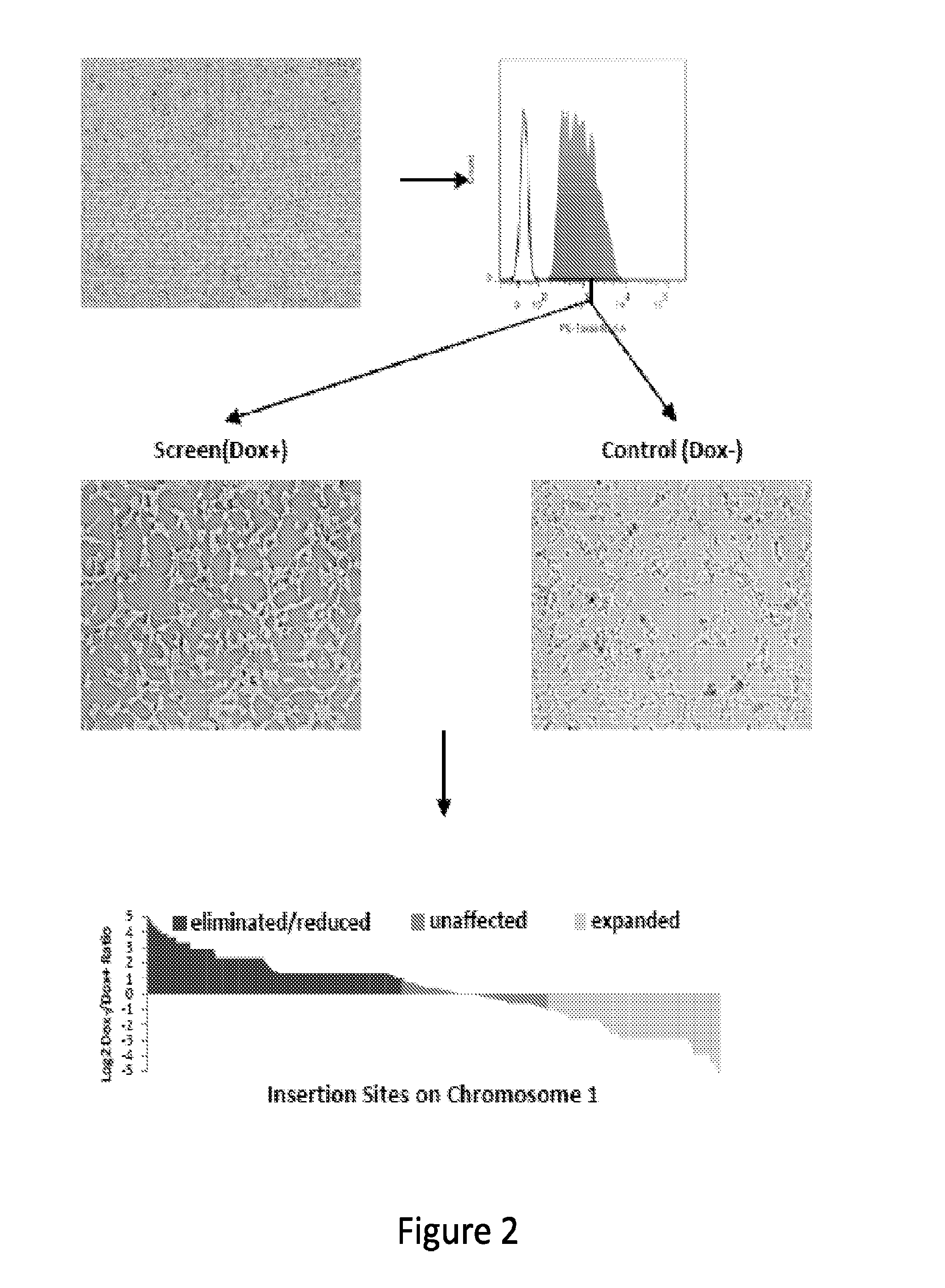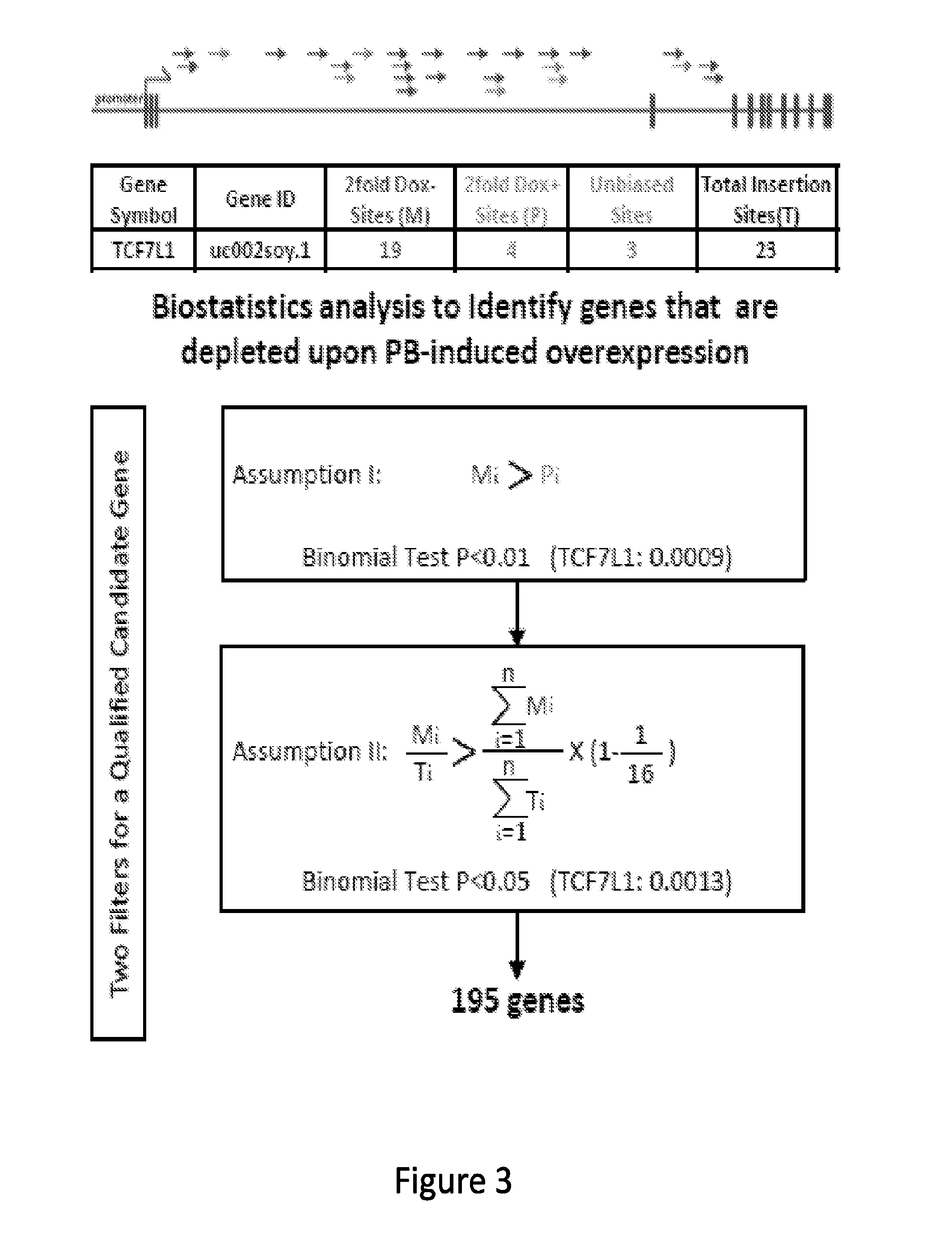Compositions and methods of using transposons
a technology of composition and method, applied in the field of composition and method of using transposons, can solve the problems of lack of genome-wide gain-of-function screening for negatively selected genes, difficult approach to directly targeting oncogenic alteration or pathway, etc., and achieve the effect of reducing tumor cell proliferation
- Summary
- Abstract
- Description
- Claims
- Application Information
AI Technical Summary
Benefits of technology
Problems solved by technology
Method used
Image
Examples
example s
[0123]The invention is further described in detail by reference to the following experimental examples. These examples are provided for purposes of illustration only, and are not intended to be limiting unless otherwise specified. Thus, the invention should in no way be construed as being limited to the following examples, but rather, should be construed to encompass any and all variations which become evident as a result of the teaching provided herein.
[0124]Without further description, it is believed that one of ordinary skill in the art can, using the preceding description and the following illustrative examples, make and utilize the compounds of the present invention and practice the claimed methods. The following working examples therefore, specifically point out embodiments of the present invention, and are not to be construed as limiting in any way.
[0125]The Materials and Methods used in the experiments described in Example 1 disclosed herein are now described.
[0126]Summary o...
example 1
PB Gain-of-Function Screen
[0178]A PB transposon containing a doxycycline (Dox)-inducible system was generated to drive endogenous gene overexpression upon insertion (PB[Mut-tetO-KAT-TETRKRAB], FIG. 1). The mutated cells are also labeled by co-expression of the Katushka (KAT) fluorescent marker. This was applied to a KRASG12V transformed cell line, AML-RAS, which was generated by introducing oncogenic KRASG12V into a patient-derived TSC2-deficient angiomyolipoma cell line, TRI-102. TRI-102 is a slow growing benign tumor cell line that cannot form colonies in soft agar. Introducing KRASG12V into these cells increases proliferation and allows anchorage-independent growth (FIGS. 13A and 13B), transformed features commonly displayed by patient-derived cancer cells with activated RAS mutations. Thus, AML-RAS and TRI-102 provide the ideal experimental and control cell lines to screen for RAS synthetic lethal mutations.
[0179]To screen for mutations that impair the growth or survival of AML-...
example 2
PB Transposon-Based Conditional Mutagenesis Screen
[0188]A forward genetic approach is needed to functionally interrogate the large number of noncoding genes. Given the complexity of alternative splicing and the limited characterization of noncoding genes in the human genome, a systematic gene activation approach is described herein to perform whole genome interrogation. A screening method utilizing piggyBac (PB) transposon mutagenesis-based conditional expression system coupled with high-throughput sequencing analysis was developed. Utilizing this method, a negative selection screen for genes that impair the growth and / or survival of cancer cells expressing oncogenic KRAS was conducted. In a single round of PB mutagenesis, 18,032 protein-coding genes, 10,362 long noncoding RNAs (lncRNAs) and 8,683 pseudogenes were successfully interrogated. Intriguingly, both protein-coding and noncoding components of the WNT signaling pathway were uncovered to specifically antagonize oncogenic RAS....
PUM
| Property | Measurement | Unit |
|---|---|---|
| Pressure | aaaaa | aaaaa |
| Electrical resistance | aaaaa | aaaaa |
Abstract
Description
Claims
Application Information
 Login to View More
Login to View More - R&D
- Intellectual Property
- Life Sciences
- Materials
- Tech Scout
- Unparalleled Data Quality
- Higher Quality Content
- 60% Fewer Hallucinations
Browse by: Latest US Patents, China's latest patents, Technical Efficacy Thesaurus, Application Domain, Technology Topic, Popular Technical Reports.
© 2025 PatSnap. All rights reserved.Legal|Privacy policy|Modern Slavery Act Transparency Statement|Sitemap|About US| Contact US: help@patsnap.com



